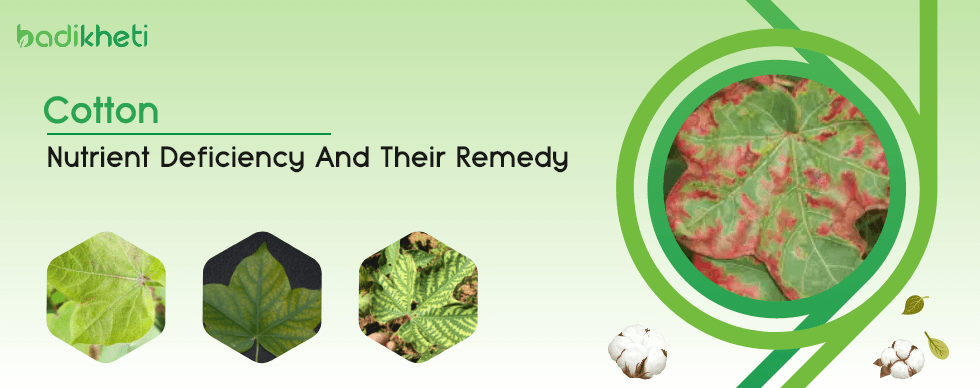
As a result of the introduction of new high-yielding types and hybrids of cotton seeds, the rapid depletion of soil nutrients has become a limiting factor in cotton production. As a result, cotton farmers have raised the application rate of main plant nutrients in the form of concentrated fertilizers each year, resulting in the depletion of secondary and micronutrients from the soil. In this blog, we will take a look at the common nutritional deficiencies in cotton and their solutions.
Nitrogen deficiency is the major cotton deficiency that a farmer needs to face. The most obvious sign of it in cotton plant is that the leaves are a pale yellowish green color and are getting smaller. In the end, the cells become disorganized, and red pigments called anthocyanins start to form. A plant that doesn’t have enough nitrogen also has little vegetative growth, lacks vigor, and grows slowly.
Nitrogen deficiency symptoms tend to be worse in cotton that grows in soils with a rough texture and not much organic matter.
You can administer urea-based fertilizers for cotton to cure nitrogen deficiency. It is a common cotton nutrient deficiency solution. Urea is a small organic compound that moves quickly into the plant. Within 6 hours, urea-N can be found in the bolls. Within 24 hours, most of the urea-nitrogen that the leaf took in will have moved into the bolls. Cotton will store nitrogen as protein in its leaves during times when there is more of it so that it can use it later.
Cotton plants with a phosphorus deficiency have smaller, darker green leaves. Cotton’s older, lower leaves are the first to show signs of shortage. Extreme phosphorus deficit causes not only a diminution in plant size but also a loss of secondary branches and a decrease in the total number of cotton bolls. The cotton bolls’ flowering, fruiting, and ripening are all slowed as a result.
The phosphorus shortage can be remedied by applying a foliar solution of DAP at a concentration of 2%.
Cotton rust is a striking sign of malnutrition caused by a lack of potassium. There are yellowish white spots on the leaves, and between the veins, the color of the leaves changes to light yellowish green. The tips and edges of the leaf break off and curl down. Lastly, the whole leaf turns reddish brown, dries out, and falls off the plant too soon. This stops the cotton bolls from growing normally, so they stay small and immature. Many bolls don’t open at all because the fiber inside isn’t very good.
Combating the nutrient deficiency of cotton such as Potassium is possible with foliar sprays(as potassium nitrate or potassium sulphate). The shortage can be remedied in as little as 20 hours with foliar K treatments. Three to four foliar applications of around 1.36 K/acre should be applied at least a week apart to address the deficit, depending on the cotton boll load.
A high nutrient absorption rate is one of the most desirable characteristics of cotton seeds. With such type of cotton seeds, one can reduce the possibility of various nutrient deficiencies in cotton. Remember, addressing nutrient deficiency is a part of the holistic cotton plant protection plan. You need to combine it with cotton disease protection and cotton pest protection to achieve a good cotton crop.
A good cotton seed is the foundation of a good cotton crop. Buy cotton seeds online from Badi Kheti, India’s most trusted online seed seller with the top agriculture brands in India.
Cotton is one of the most important crops in India, accounting for about 15% of the total agricultural output. However, choosing the best cotton seeds for your farm can be a challenging task, as there are many factors to consider, such as yield potential, pest resistance, climate suitability, and quality. In this blog post, we will provide you with some tips and guidelines on how to select the best cotton seeds for your farm in India, based on your specific needs and goals. Tips to...
The cotton industry is often misunderstood due to outdated myths about its environmental impact. However, modern farming techniques have greatly reduced the energy, water, and chemical usage of cotton production, making it a more sustainable crop than it was in the past. Let's dispel some of the most common myths related to cotton's sustainability and show some reality. Myth: Cotton is energy intensive. Reality: The cotton industry has reduced its energy use by more than 50% over the last four decades. With the implementation of...
Cotton is one of India's most important fiber and cash crops. It provides the Cotton textile industry with Cotton fiber, its primary raw material. Cotton provides direct income to six million farmers in India, while between forty and fifty million people are involved in the cotton trade and its processing. The cotton plant thrives in warm climates. It cannot handle temperatures below 60 degrees Fahrenheit. If you reside in a chilly climate, it is best to start the plant indoors and move it outside once...